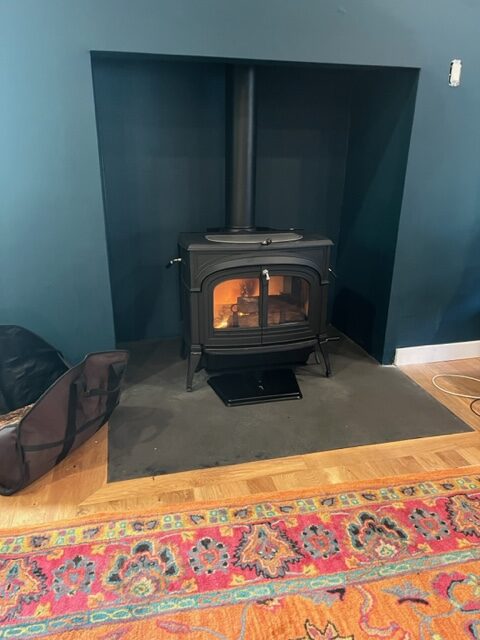Creosote is a highly flammable black or brown residue that accumulates inside a fireplace and chimney due to the burning wood. Creosote can be hard, sticky, drippy, rusty, or fluky depending on several factors, including the wood type and stage of buildup. All forms of creosote pose severe dangers to a home due to their highly flammable nature. Leaving creosote to build up in your chimney and fireplace substantially raises the risk of fires within.
What Causes Creosote?
When you burn wood, the resultant fire releases particles, gases, and other chemical compounds. As the combustion byproducts find their way up the chimney, they condense and settle on chimney walls. This condensation eventually turns into creosote. As creosote builds up, it goes through three stages:
- First stage creosote is flaky and easy to remove. You can easily remove it with a standard chimney brush. It is mainly formed due to a combination of good wood combustion and relatively high temperatures in your chimney.
- Second stage creosote comes as a shiny glass-like compound that can’t be removed with standard brushes. Second stage creosote needs professional removal.
- Third stage creosote is thicker and sticky with tar-like properties. Third stage creosote also requires professional removal. In some severe buildup, professionals may recommend the removal and replacement of the chimney liner.
Dangers of Creosote
As mentioned earlier, creosote is a highly flammable substance responsible for many fire incidents. A stray spark or even high temperatures in your chimney can easily ignite it. Experts reveal creosote fires can hit 2,000 degrees Fahrenheit, causing the chimney liner to crack and flames to spread quickly in your home. Additionally, exposure to creosotes can be harmful to your health. Eating food or drinking water contaminated with creosote can result in various health issues.
Tips to Minimize Creosote Buildup
The U.S. Consumer Product Safety Commission reveals there are over 17,000 chimney-related fires in the U.S. each year.
The following are some of the tips to reduce creosote buildup and avert chimney fires:
- Use the right wood type: You should only use dry, seasoned firewood. Recently cut wood has too much moisture that emits dense black smoke and myriads of combustion byproducts. Seasoned and dry firewood burns completely while producing less smoke and less creosote.
- Avoid artificial logs: Synthetic logs have more combustion byproducts compared to natural wood. This ultimately increases the creosote buildup in your fireplace and chimneys.
- Use the right fire design: You can avoid creosote buildup by adopting a clean-burning fire design. When stacking firewood, ensure there is adequate space between the logs for oxygen to circulate easily. Efficient building fires ensure minimal smoke production, resulting in less creosote buildup in your chimney.
- Ensure the fire gets enough oxygen: Before you light the fire, ensure the damper in your fireplace is open to guarantee your fire will get adequate oxygen to burn wood properly. If you are using a fireplace with glass doors, open them slightly to allow air to circulate freely.
- Schedule for an annual chimney inspection and clean up: The National Fire Protection Association (NFPA) recommends you have your chimney inspected and cleaned by a professional at least once a year. Routine clean-ups prevent creosote buildups, thus reducing the risk of chimney fires substantially.
If you have a fireplace or wood stoves in your living space, you will probably end up with a creosote issue soon, which can be hazardous. Following the recommendations above can effectively protect your home from fire chimneys due to creosote buildup.
Chimney Sweeps in Cherry Hill, NJ, and Beyond
We are trusted and certified professional chimney cleaners that have served the needs of residential and commercial customers throughout South Jersey, Pennsylvania, and the surrounding areas since 1940. We have the right resources and experience to safely and efficiently remove creosote in your chimneys. For more information or to schedule emergency chimney service, reach out to us today.









